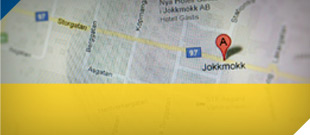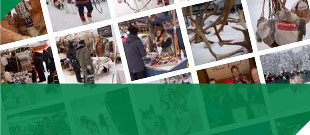Anniversary Market 1955
During the 20th century trading took on many new forms, with the arrival of post order, department stores and supermarkets. Railroads and highways were expanded and after the Second World War car ownership grew. Many traditional markets disappeared for good. Jokkmokk's final spring market was held in the beginning of the 1930s.
Jokkmokk's winter market lived on but under strong competition from shops which became more numerous as the population grew, both in the town and outlying villages. Especially the trade with animal skins remained strong. The Sámi came with both the furs of game animals and reindeer skins and sold them to the merchants from the coast. The church had worship services and Laestadian meetings, weddings and baptisms. Modern time market wares with candy for the children, trinkets and carnival rides were now part of the picture, but the winter market was also a place to purchase something new and exclusive which the local shops would not have. It was also an important occasion to meet old and new friends in the market crowd.
The municipal government of Jokkmokk had also begun to see the importance for tourism and business to maintain and also develop the market tradition. The municipal Tourism Board was given responsibility for the market. The chairman for many years was Gösta Åkerlund (1911-2001), an industrious and visionary person. He was the tavern keeper at Hotell Gästis and the director of theater for the Bio Norden cinema, both central facilities for the market celebrations. The market was still a so-called free market where anybody could come and sell their wares. Many rented space on the sidewalk from homeowners in the center of town. The Tourism Board booked the carnival rides and other entertainment and coordinated activities during the two market days, Thursday and Friday.
On the suggestion of the Tourism Board it was decided that in 1955 they would celebrate the 350th Anniversary Market. For the commemoration a special committee was chosen, led by Gösta Åkerlund and the municipal accountant, David Hedqvist. The committee gave the artist Runo Johansson Lette the assignment to create a market symbol. This logo is still used today, with a woman dressed in a Lule Sámi costume holding some cloth draped over her arm. Behind her is a reindeer with its head up. Lette made a metal sculpture a meter tall which is part of the Ájtte Museum collection. Uno Fransson, administrator of the Employment Office made a graphic version of the figure which was used for printing up material for advertisement such as posters and lapel pins.
The actress Ingrid Bergman who happened to be in Stockholm at this time was invited to the market by Gösta Åkerlund, but she had other engagements and could not come. But there was both a theater company and a circus for the celebration. More than one hundred merchants were here for the market of 1955, compared with the 30 to 40 of a normal year. And there were ten thousand visitors. The market area stretched from Borgarplatsen to the Outdoor Homestead Museum and not through the central part of town as had been the custom. There was a reindeer herd on the ice of the newly dredged Talvatis Lake. Local merchants were encouraged to attract customers by dressing in turn of the century clothing and burning outdoor torches in front of their shops. The market was lengthened by one day, Thursday through Saturday.
A commemorative publication "Jokkmokk's Market 1605-1955" was put together. A film produced by Gösta Åkerlund was also completed in time for the market, a film which is still shown.
The 350th anniversary celebration was a turning point for Jokkmokk's Market and has grown year by year since then. Guidelines for present day markets were drawn up in an attempt to raise the quality of the wares on sale and the cultural program with exhibits and seminars. The traditional reindeer caravan that goes through the town was carried out for the first time, with Amul Länta leading it. There were ideas which didn't materialize then but became reality later, such as ice and snow sculptures. At the initiative of Gösta Äkerlund the market symbol was carved in snow for the first time in 1961 by Albert Falck, a teacher. It was placed outside Svensson's hardware store on Storgatan. It wasn't until the beginning of the 1990s that Albert Falck was asked to re-do the snow sculpture. Since then he has carved it every year for the market.












